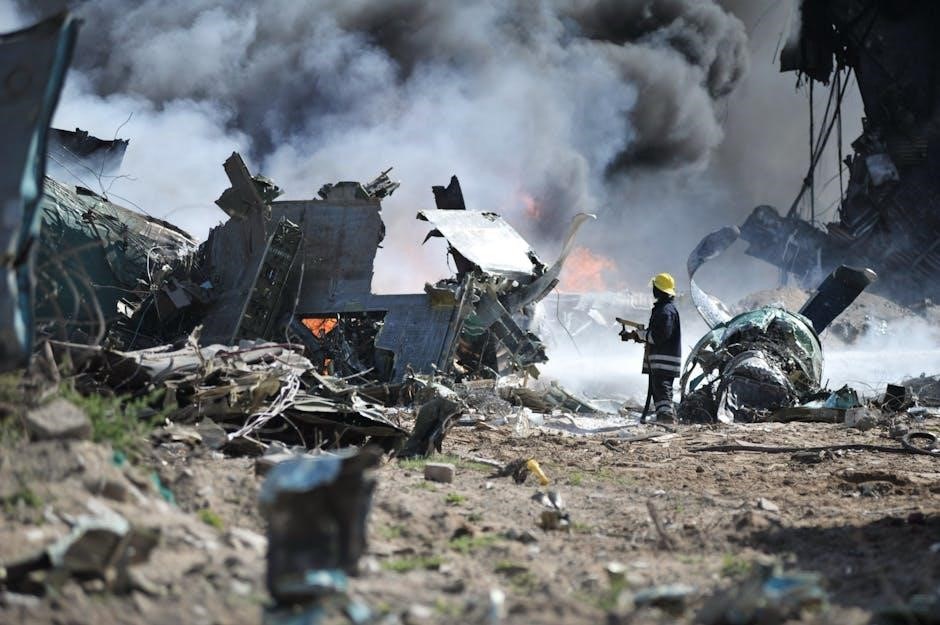An accident incident report form is a crucial document for recording workplace incidents, injuries, or near-misses. Available in PDF and other formats, it ensures detailed and accurate documentation, promoting workplace safety and compliance with legal requirements.
Definition and Purpose
An Accident Incident Report Form is a standardized document designed to record detailed information about workplace incidents, injuries, or near-misses. Its primary purpose is to ensure accurate documentation of facts, including what happened, who was involved, and the circumstances surrounding the event. This form is essential for legal compliance, insurance purposes, and internal investigations. By capturing critical details, it helps organizations identify root causes, implement safety measures, and prevent future incidents. Available in formats like PDF, Word, and Excel, it offers flexibility for easy customization and accessibility. Completing the form promptly ensures timely reporting and fosters a culture of safety and accountability within the organization.
Importance in Workplace Safety
An Accident Incident Report Form plays a vital role in maintaining workplace safety by providing a clear and structured way to document incidents. It ensures that all details are captured promptly, reducing the risk of memory gaps or inaccuracies. This documentation is essential for investigating causes, identifying potential hazards, and implementing preventive measures to avoid future incidents. Additionally, it aids in compliance with regulatory requirements, such as OSHA standards, and helps organizations reduce liability. By fostering a culture of accountability and transparency, the form contributes to a safer working environment. Regular use of these forms also enables organizations to track trends, improve safety protocols, and ensure continuous improvement in workplace safety practices.

Key Components of an Accident Incident Report Form
The form typically includes sections for personal details, incident description, witness statements, and signatures, ensuring comprehensive documentation for accurate analysis and follow-up actions.
Personal Information Section
The Personal Information Section of an accident incident report form collects essential details about the individuals involved, including the person completing the report and those affected by the incident. This section typically includes fields for names, job titles, departments, and contact information. For employees, it may also request employee IDs or dates of employment. For non-employees, such as visitors or contractors, it may ask for their role or relationship to the organization. Additionally, this section often includes spaces for the dates and locations of the incident. Accurate and complete personal information is critical for follow-up investigations, communication, and ensuring accountability. It also helps in verifying the identities of all parties involved and facilitates proper documentation for legal and administrative purposes. This section is a cornerstone of the report, providing clarity and context from the outset, while ensuring compliance with data protection laws like GDPR or CCPA. Some templates may also include additional fields for specific details, such as supervisor information or insurance details, depending on the organization’s requirements. This ensures that all necessary stakeholders are notified and involved in the next steps, promoting efficiency and transparency in the reporting process. By maintaining accurate records, organizations can better track incidents, identify trends, and implement preventive measures to enhance workplace safety and reduce future risks. This section serves as the foundation for the entire report, enabling effective communication and ensuring that all relevant parties are informed and engaged throughout the process. The personal information section is designed to be user-friendly, allowing individuals to provide their details quickly and accurately, which is essential for timely reporting and response. Overall, this section plays a vital role in the overall effectiveness of the accident incident report form, making it an indispensable component of workplace safety management. By ensuring that all personal details are captured accurately, organizations can streamline their incident management processes and improve outcomes for everyone involved.
Incident Details and Description
The Incident Details and Description section provides a comprehensive account of what occurred during the accident or incident. This part of the form typically includes the date, time, and location of the incident, as well as a detailed narrative of events leading up to and during the incident. It may also involve descriptions of injuries sustained, property damage, or equipment involved. The section often includes a sequence of events timeline, helping to clarify the cause and progression of the incident. Additionally, it may ask for information about contributing factors, such as environmental conditions, equipment malfunctions, or safety violations. This section ensures a clear understanding of the incident for investigations and corrective actions. Including witness accounts and visual aids like diagrams or photos can enhance the report’s accuracy and completeness.
Witness Statements and Signatures
The Witness Statements and Signatures section is crucial for validating the details of an incident. It includes accounts from individuals who observed the accident, providing an unbiased perspective. Witnesses may describe what they saw, heard, or experienced, offering valuable insights into the incident’s cause and sequence. Their statements help corroborate the information provided by the parties directly involved, ensuring a more accurate report. This section also requires the signatures of witnesses, confirming their agreement with the recorded statements. In some cases, contact information for witnesses may be included for follow-up. The inclusion of witness signatures adds authenticity to the report, making it a reliable document for investigations and legal purposes. This section strengthens the credibility of the incident report, aiding in fair and accurate resolutions.

Types of Incident Reports
Incident reports vary in type and purpose, including workplace accidents, vehicle incidents, and near-miss events. Each serves a specific purpose to ensure accountability and safety.
Workplace Incident Reports
Workplace incident reports are essential for documenting accidents, injuries, or near-misses occurring in professional settings. These reports typically include details about the incident, such as the date, time, and location, as well as information about the individuals involved, including employees, supervisors, and witnesses. They also describe the nature of the incident, the causes, and the resulting injuries or damages. Workplace incident reports are crucial for maintaining workplace safety, ensuring compliance with legal requirements, and facilitating insurance claims. Employers often use these reports to identify safety hazards, implement preventive measures, and provide support to affected employees. Accurate and timely reporting helps organizations improve workplace conditions and reduce future risks.
Vehicle Incident Reports
Vehicle incident reports are detailed documents used to record accidents or near-misses involving company or personal vehicles. These reports typically include the date, time, and location of the incident, as well as information about the vehicles and individuals involved. They also document the sequence of events, potential causes, and any resulting damages or injuries. Vehicle incident reports are critical for insurance claims, legal proceedings, and internal reviews. They help organizations assess liability, identify safety improvements, and ensure compliance with transportation regulations. Additionally, these reports often include witness statements, photos, or diagrams to provide a comprehensive understanding of the incident. Accurate reporting is essential for resolving disputes and preventing future accidents on the road.
Near-Miss Incident Reports
Near-miss incident reports document situations where an accident or injury nearly occurred but was avoided. These reports are crucial for identifying potential hazards and preventing future incidents. They often include details such as the date, time, and location of the near-miss, the individuals involved, and a description of what happened. The root cause of the near-miss is also analyzed to implement corrective actions. Unlike traditional accident reports, near-miss reports focus on proactive safety measures rather than reacting to harm already done. Organizations use these reports to improve safety protocols, reduce risks, and enhance overall workplace or operational safety. By addressing near-misses, companies can prevent future accidents and create a safer environment for everyone involved.

Downloading and Customizing Templates
Downloading accident incident report templates is straightforward, with many free PDF options available online. Customize them to fit specific organizational or industry needs for accurate and efficient reporting.
Free PDF Templates Available Online
Free accident incident report form PDF templates are widely available online, offering a convenient starting point for organizations. These templates are often downloadable from official government websites, OSHA resources, or legal document platforms. Many templates are designed to be user-friendly, with fillable fields that can be completed electronically or printed for manual use. They typically include sections for personal details, incident descriptions, witness statements, and signatures, ensuring comprehensive documentation. Websites like Template.net, Formsbirds, and PandaDoc provide customizable options that cater to various industries. Using these templates saves time and ensures compliance with legal standards. Always preview the template to ensure it aligns with your specific needs before downloading and customization.

How to Customize Templates for Specific Needs
Customizing accident incident report form PDF templates involves tailoring them to meet your organization’s unique requirements. Start by adding or removing sections based on the type of incidents common to your industry. For example, workplaces with heavy machinery may need detailed sections on equipment malfunctions, while transport companies might require vehicle-specific fields. Use editing software like Adobe Acrobat to modify text, add logos, or include branding elements. Ensure the language aligns with your company’s policies and compliance standards. You can also incorporate industry-specific data fields, such as safety protocols or regulatory references. Additionally, enhance usability by organizing sections logically and improving readability with clear fonts and spacing. Finally, test the template with real-world scenarios to ensure it captures all necessary information effectively.

Step-by-Step Guide to Filling Out the Form
Fill out the accident incident report form PDF systematically, providing clear and accurate details about the incident, including dates, locations, and involved parties. Use concise language to describe what happened, ensuring all relevant information is captured without unnecessary elaboration. This methodical approach helps maintain clarity and ensures all critical data is recorded for proper documentation and follow-up actions.
Gathering Necessary Information
Gathering accurate and detailed information is the first step in completing an accident incident report form PDF. Start by identifying the date, time, and location of the incident. Collect personal details of all individuals involved, including names, positions, and contact information. Document the sequence of events leading up to the incident, ensuring facts are objective and unbiased. Include descriptions of injuries, damages, or property loss. Obtain witness statements and their contact details for potential follow-up. Take photos or videos of the scene if possible, and note any safety measures that were in place. This thorough approach ensures the report is comprehensive and reliable for further investigation or legal purposes.

Completing the Form Accurately
Completing the form accurately involves using clear and concise language to describe the incident. Avoid assumptions and stick to the facts gathered during the information collection phase. Ensure all sections of the accident incident report form PDF are filled out thoroughly, paying attention to details like dates, times, and descriptions. Double-check the information for accuracy to prevent errors. Incomplete or inaccurate reporting can lead to misunderstandings, delays in investigations, or even legal repercussions. It’s essential to review each section carefully before finalizing the report. This ensures that the documentation is reliable and serves its purpose effectively in addressing the incident and preventing future occurrences.
Reviewing and Submitting the Report
After completing the accident incident report form PDF, it’s crucial to review the document for accuracy and completeness. Check for any missing information, inconsistencies, or typos that could lead to confusion. Ensure all details align with the facts gathered and that the narrative is clear and objective. Once satisfied, submit the report to the designated authority, such as a supervisor, HR department, or safety officer, within the required timeframe. Timely submission is essential for initiating investigations and corrective actions. Maintain a copy of the submitted report for personal or departmental records. Proper review and submission ensure the report is actionable and meets organizational or regulatory standards.

Legal and Compliance Considerations
Adherence to OSHA standards and data protection laws ensures confidentiality and regulatory compliance. Timely reporting and accurate documentation prevent legal repercussions, while proper storage safeguards sensitive information.
OSHA Requirements for Incident Reporting
OSHA mandates employers to report work-related incidents involving injuries, illnesses, or fatalities. The OSHA 300 log and Form 301 are essential for documenting incidents. Employers must record details like the incident date, location, and nature of the injury. Severe incidents, such as hospitalizations or fatalities, must be reported within eight hours. Accuracy in reporting is critical to avoid penalties. Employers are also required to maintain records for five years. OSHA standards ensure transparency and accountability in workplace safety. Proper documentation helps identify hazards and prevent future incidents. Failure to comply with OSHA reporting requirements can result in fines and legal action. Employers must ensure all incidents are thoroughly investigated and documented to meet OSHA’s strict guidelines.
Compliance with Data Protection Laws
Compliance with data protection laws is essential when handling accident incident reports. These documents often contain sensitive personal information, such as names, addresses, and medical details, which must be protected under regulations like GDPR and CCPA. Employers are responsible for ensuring that incident reports are stored securely, with access restricted to authorized personnel only. Data should be anonymized where possible to safeguard individual privacy. Employers must also inform individuals involved in incidents about how their data will be used and shared. Failure to comply with data protection laws can result in legal penalties and reputational damage. Regular audits and staff training are recommended to maintain compliance and ensure the confidentiality of sensitive information.
Clery Act Requirements for Educational Institutions
Educational institutions in the U.S. must comply with the Clery Act, which mandates reporting of crimes and certain incidents on or near campus. Accident incident reports play a role in this compliance, as they document incidents involving students, staff, or visitors. The Clery Act requires institutions to collect and disclose data on crimes, accidents, and other safety-related incidents. This includes maintaining records of incidents, such as injuries, fires, or violent crimes, and reporting them annually. Failure to comply can result in fines and loss of federal funding. The Clery Act ensures transparency and accountability, helping to create a safer environment for the campus community. Institutions must train staff to accurately report incidents and maintain detailed records for audits and public disclosure.

Best Practices for Using the Form
- Ensure accuracy and completeness when filling out the form.
- Report incidents promptly to maintain timeliness.
- Maintain objectivity and avoid bias in documentation.
- Provide training to staff on proper form usage.
- Store reports securely to protect sensitive information.
Ensuring Accuracy and Completeness
Accuracy and completeness are critical when filling out an accident incident report form. Ensure all details are factual and unbiased, avoiding assumptions or speculation. Include precise descriptions of the incident, such as dates, times, locations, and the sequence of events. Gather witness statements and attach any supporting documents, like medical reports or photographs. Use clear and concise language to prevent misinterpretation. Double-check the form for errors or omissions before submission. Incomplete or inaccurate reports can lead to legal issues, delayed investigations, or inadequate corrective actions. Training employees on proper reporting practices can enhance the quality of submissions. Regular reviews of completed forms help identify patterns and improve future reporting processes.
Importance of Timeliness in Reporting
Timeliness in submitting an accident incident report is crucial for effective incident management. Delayed reporting can lead to incomplete or inaccurate information, as details may be forgotten or evidence lost. Prompt reporting ensures that investigations are conducted while the incident is still fresh, allowing for a more thorough analysis. It also enables quicker implementation of corrective actions to prevent future incidents. Additionally, timely reporting facilitates compliance with legal and regulatory requirements, reducing potential liabilities. Early documentation supports injured parties in receiving timely medical attention and facilitates insurance claims. Organizations should establish clear timelines for reporting incidents to maintain accountability and efficiency. Timely reporting demonstrates a commitment to safety and responsible incident handling.
Maintaining Objectivity in Documentation
Maintaining objectivity in an accident incident report is essential for ensuring credibility and fairness. Documentation should focus on factual information, avoiding personal opinions or biases. All details, such as dates, times, locations, and witness accounts, should be recorded accurately without speculation. Using clear and concise language helps prevent misinterpretation. Photographs, videos, and physical evidence should support the narrative without alteration. Objectivity ensures that all parties involved are represented fairly, reducing the risk of legal disputes. It also aids in identifying root causes and implementing corrective actions. By adhering to impartial documentation, organizations foster trust and accountability. This approach supports transparent investigations and promotes a culture of safety and integrity. Objectivity in reporting is a cornerstone of effective incident management and legal compliance.

Examples of Incident Reports
Examples include workplace accidents, vehicle incidents, and near-miss events. Each provides a clear, factual account of what occurred, helping organizations improve safety and compliance.
Workplace Accident Example
A workplace accident example includes a slip-and-fall incident in a manufacturing facility. The report details the injured employee’s name, job title, and department. It outlines the incident’s date, time, and location, such as “January 10, 2023, at 2:15 PM in the warehouse area.” A brief description explains how the employee slipped on spilled oil, fell, and sustained a sprained ankle. The report notes witness statements from two coworkers who provided immediate assistance. It also includes a root cause analysis, identifying poor housekeeping as the primary factor. Preventive measures, like increasing cleaning schedules and providing safety training, are documented. This example serves as a template, ensuring clarity and thoroughness when documenting workplace incidents.
Vehicle Incident Example
A vehicle incident example involves a car accident during a company delivery. The report includes details of the driver, vehicle make/model, license plate, and insurance information. It describes the incident: a collision at an intersection due to another vehicle running a red light. Witness statements from bystanders and photos of the damage are noted. The report documents injuries, such as whiplash, and property damage, like a cracked windshield. Actions taken, such as calling the police and exchanging information, are recorded. This example illustrates how to document vehicle incidents clearly, ensuring all relevant details are captured for insurance and legal purposes. It serves as a practical template for accurate and comprehensive reporting.
Near-Miss Incident Example
A near-miss incident example involves a situation where a potential accident was narrowly avoided. For instance, a worker in a warehouse nearly collided with a forklift due to poor visibility. The report would document the date, time, and location of the incident, as well as the individuals involved. It would describe how the near-miss occurred, such as inadequate lighting or lack of communication. The report would also include witness accounts, if any, and note that no injuries or damages occurred; However, it would highlight the potential risks and recommend corrective actions, like improving lighting or enhancing safety protocols. This example demonstrates the importance of reporting near-misses to prevent future accidents and improve workplace safety measures.
Accurate incident reporting ensures workplace safety, accountability, and continuous improvement. Proper documentation fosters a culture of transparency and preparedness, ultimately protecting employees and organizational resilience.
Final Thoughts on the Importance of Incident Reporting
Incident reporting is a cornerstone of workplace safety and accountability, providing valuable insights to prevent future accidents. By documenting incidents accurately, organizations can identify root causes, implement corrective actions, and foster a culture of safety. Timely and detailed reporting also ensures compliance with legal requirements, protecting both employers and employees. Moreover, incident reports serve as a proactive tool for continuous improvement, enabling organizations to learn from past events and enhance their safety protocols. Ultimately, the consistent use of accident incident report forms strengthens accountability, reduces risks, and promotes a safer, more responsible work environment for everyone involved.
